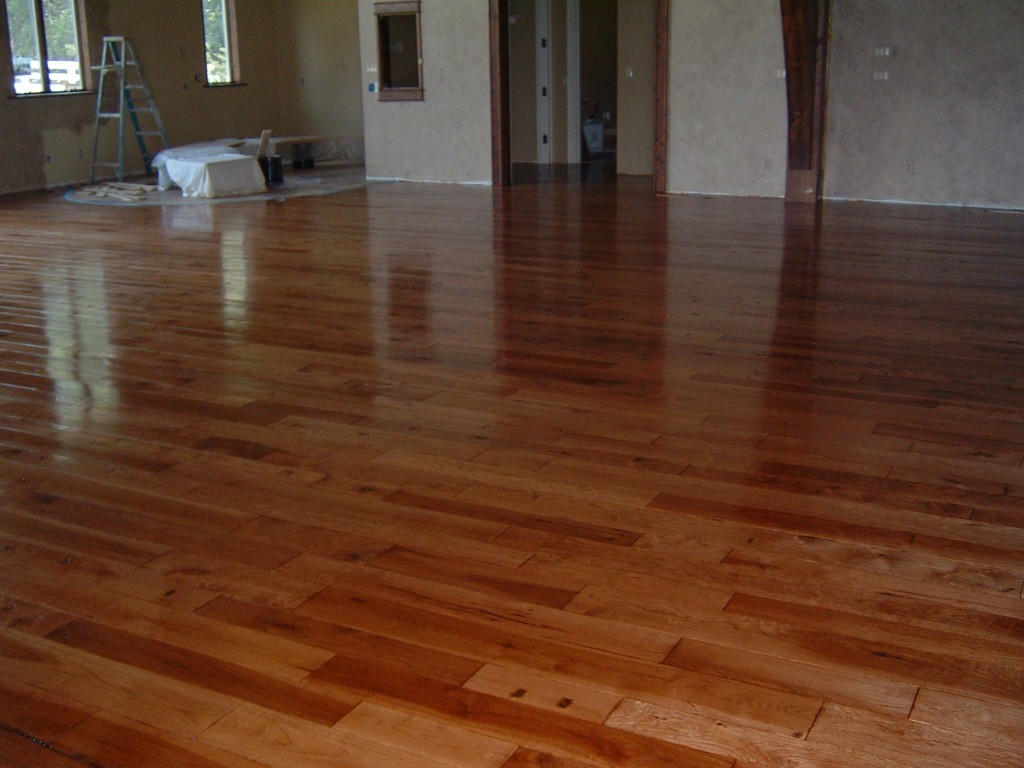So you have a brand new hardwood floor. You either have a new home, or we have installed a new wood floor in your existing home. Maybe you have never had a wood floor before. What are you supposed to do, are you afraid to walk on the floor, or afraid you will scratch the floor? It can happen, but hopefully with these helpful hints, it won’t.
- Moving in Appliances. We see more damage from moving in cook stoves, dishwashers, and refrigerators than any other items. Buy a couple sheets of 1/4 or 1/2 inch plywood or chipboard to lay on the floor to protect it from appliance feet, wheels and dolly wheels. Keep the appliances on this plywood until they are completely in place. DO NOT RELY ON REFRIGERATOR WHEELS!! Deep scratches or dents from heavy appliances can be very expensive to fix, and could result in the entire floor having to be re-sanded/refinished. Wood floors are hard and they are tough, but refrigerators are very heavy and the wheels are fairly narrow, so there’s a lot of pounds per square inch on the wheels.
- Furniture. Place felt pads on all furniture that moves…….Chairs, bar stools, coffee tables, recliners, etc. If you move your couch around frequently, put them on the couch also. Make sure that the pads are large enough to cover the entire “foot” of the furniture, and make sure the pads are kept clean. This may mean replacing the pads on the dining room chairs a couple times per year, especially in dusty/sandy areas.
- Check your outside shoes at the door. Or at the very least, check your shoes for nails, tacks and gravel that may be lodged in the soles. Changing your outside shoes when you come inside is a good option. That really prevents a lot of outside dirt from coming in also.
- When you are moving in, check all boxes for gravels lodged in the cardboard on the bottom and for large steel or copper staples that may be on the bottom of the boxes. Don’t slide cardboard boxes around on the new floor.
- Don’t use rugs or towels to slide heavy furniture around on the floor. This may not prevent a scratch or a scuff. Sometimes the feet of the furniture happens to find a thin spot, and by the time you see the damage, it’s too late. In a similar vein, don’t use the plastic moving or “magic casters” to move heavy furniture either. I know they look like they work on TV, but all it takes is to get a gravel under the edge of one, and it’s all over. The only correct way to move in furniture on a new floor is to carry and place it in.
- Keep pets and rugs off the floor for at least 3 days after the final coat of finish. Keep pets (especially heavy dogs over 20 pounds) nails trimmed. Animals that have learned to run around on carpeted floors will not understand that the wood floors are different, until they get used to them.
- It is always good to have all the landscaping done, all the concrete approaches and sidewalks done, and the garage cleaned well before move in day. You wouldn’t believe how many new homeowners I’ve seen trying to move in to their new home when the house is surrounded by mud. I understand that everyone is anxious to move into their new home, but it is really better to wait till you’re really ready.
- Our floor finish is 90% cured after 24 hours, 98% cured after 3 days and fully cured after about a week. You can walk on 90% cured floor finish, and wood floor finish is very scuff and scratch resistant, but it can scuff a lot easer in the first 24 hours. You should be especially careful during this time. That extra 10% really makes a huge difference. All wood floor finishes are very hard, but finish companies have to balance hardness with other things, such as chipping resistance. If the finish is made too hard, it will/can chip and flake off, so even though the finishes are very hard, they aren’t as hard as steel or a diamond!!
- No finish will prevent denting of the wood from heavy objects that may be dropped on the floor. An object like a hammer, or even a can of peaches or green beans, if dropped just right can dent a wood floor. These dents usually can’t be repaired without sanding and refinishing, but normally they will just be written off as the patina of the floor. Most people (except for you of course) won’t even notice them. Sometimes if the dents are “sharp and deep” we can repair them with a clear epoxy, similar to how a dentist would repair a cavity. But this isn’t always the case.
- If you have any questions or concerns, please don’t hesitate to call or send us an e-mail.
